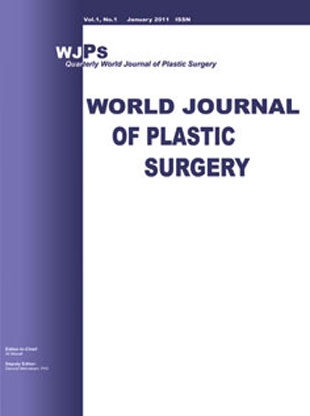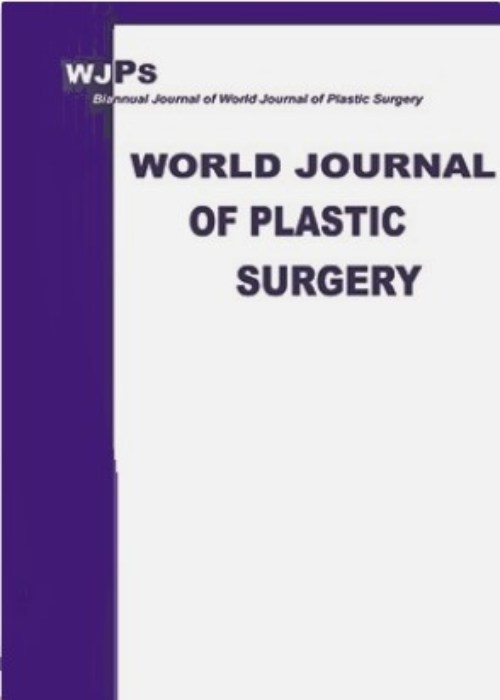فهرست مطالب

World Journal of Plastic Surgery
Volume:2 Issue: 2, Jun 2013
- تاریخ انتشار: 1392/02/20
- تعداد عناوین: 9
-
-
Pages 65-70In cell therapy and regenerative medicine, a reliable source of stem cells together with cytokine growth factors and biomaterial scaffolds seem necessary. As adipose tissue is easy accessible and is abundant source of adult stem cells and can differentiate along multiple lineages, it can be considered as a good candidate in aesthetic medicine. The clinical application of adipose-derived stem cells (ASCs) is reviewed in this article.Keywords: Adipose, Stem cell, Aesthetic medicine
-
Pages 71-80Nanotechnology is an emerging discipline, having power to revolutionarize every scientific field to a very deep level which previously thought to be a science fiction. Having a great potential to beneficially change the way a disease is diagnosed, treated and prevented, nanotechnology practically impacts on state of the art healthcare technologies and plays a crucial role in changing the field of surgery. Surgeons are constantly looking for minimally invasive ways to treat their patients, as recovery is faster when a lesser trauma is inflicted upon a patient, scarring is lessened and there are usually fewer complications in the aftermath of the operation. Through nanotechnology, tiny biosensors could be constructed which could take these factors into account, thus shortening the patient recovery period and saving hospitals money, reducing infection rates within the hospital, reducing the waiting lists for operation and allowing doctors to treat more patients in the same period of time. This review employs a thematic analysis of online series of academic papers focuses on the potentials of nanotechnology in surgery, especially in plastic surgery and addresses the possible future prospects of nanotechnology in this field.Keywords: Nanotechnology, Nanosurgery, Plastic surgery
-
Pages 81-86BackgroundDepending on the cause, 40-90% of every deep dermis insult ends up in scar formation. Several modalities have been suggested as a treatment but a high rate of recurrence is reported in most of those interventions. High dose radiotherapy has been shown to be effective in reducing the recurrence rate. This study tried to determine the effectiveness of low dose rate radiotherapy following surgical excision in treating resistant keloids.MethodsBetween January 2008 and April 2011, seventeen patients (mostly burn patients) with 26 keloids went through surgical resection followed by radiotherapy. A total dose of 15 Gy in 5 fractions was administered to the areas of scar formation.ResultsAll patients were followed for at least 11 months (mostly for 20 months). No recurrence occurred. There was no complication or adverse effect.ConclusionSurgical excision followed by low dose postoperative radiotherapy was an efficient treatment for keloids that were resistant to many other modalities.Keywords: Surgical excision, Radiotherapy, Keloid
-
Pages 87-92BackgroundThe vacuum assisted closure (VAC) therapy has revolutionized the modern wound care. We developed a new concept of ‘VAC at home’ in order to decrease the hospital cost.MethodsThe study was conducted in a private hospital from January 2009 to December 2010. Only those patients were included among whom the wounds were not complicated by concomitant injury and the patients were otherwise fit to be discharged from the hospital. The VAC was applied in the hospital. The VAC changes were done after 48-72 hours depending on the general wound conditions. The cost of the VAC changes during the therapy at home was compared with the expected cost of hospital stay.ResultsThirteen patients were enrolled with a female to male ratio of 1.6:1. The mean age of male patients was 22.4 years as compared to 29.6 years in females. Road traffic accident was the most common cause. Leg (16.2%) was the commonly affected area. The average number of VACs was 15.8. The average cost of the suction machine was 100.1 USD. The average cost of the expected hospital stay during the whole therapy was 68 USD per day. The mean duration of therapy was 35.8 days. The average total cost to be paid to the hospital was 2434.4 USD. Each patient had definitely saved a net of 2739.7 USD.ConclusionWith the increasing experiences of VAC, it can safely be instituted as an ‘outpatient’ procedure to decrease the hospital cost at home.Keywords: Vacuum Assisted Closure, Home, Concept
-
Pages 93-98BackgroundBreast augmentation is the most frequent procedure performed according to the 2009 Quick Facts report of the American Society of Plastic Surgeons. This study presents the periareolar extra-glandular breast augmentation.MethodsFrom 2004 to 2010 among 32 female patients, peri-areolar incision was performed for breast augmentation. Dissection was performed in subcutaneous plane towards the inferior pole to reach the inframammary fold and was continued in the upwards direction in the subglandular plane to create a pocket. Once the implant of desired size was in place, three sutures fixed the inframammary fold. The skin incision was closed using 4-0 non-absorbable suture.ResultsThe mean age of patients was 30.7 years and the average incision length was 5.8 cm. 59.4% of patients had an implant size of more than 305 ml and less than 10% of patients had drains which were removed the next morning. All patients were followed regularly and no case of implant infection or removal was seen and only 2 patients had slight stretched scars. In one patient, the implant was high riding and no case of the capsular contracture was noticed. Changes in sensation were noted in 21.9% patients at 3 month interval which was reduced to 6.3% at 6 months interval. Similarly no case of rippling or other visible deformity was noted.ConclusionThe extra-glandular periareolar approach for the breast augmentation can be a good option with few side-effects even it is associated with a higher level of surgical expertise.Keywords: Periareolar, Extra, glandular, Breast augmentation
-
Pages 99-103BackgroundNasal valve collapse and especially internal nasal valve insufficiency is a common cause of nasal airway obstruction. This study compares the effects of spreader graft and overlapping lateral crural technique on rhinoplasty by rhinomanometry.MethodsFifty patients were randomly assigned into two groups and underwent spreader graft or overlapping lateral crural technique. Objective assessment was performed by clinical examination and rhinomanometry before and after rhinoplasty.ResultsNasal obstruction had no significant difference before and after rhinoplasty and no significant difference was observed between surgical techniques. Right, left and total nasal flow and resistance were different before and after surgery but were not significant. Base of the nose was not significantly different between two groups, but nasal projection was 2 mm in the the group who underwent overlapping lateral crura technique and the difference was statistically significant. Our study showed that both overlapping lateral crura and spreader graft technique were beneficial in rhinoplasty and they could provide enough internal nasal valve support. The overlapping lateral crura was an appropriate surgical technique for tip projection in comparison to spreader graft.ConclusionThe overlapping lateral crura technique was shown to be a better surgical way for tip projection in comparison to spreader graft.Keywords: Spreader graft, Lateral crural technique, Rhinoplasty, Rhinomanometry
-
Pages 104-110BackgroundVarious studies have been conducted in many countries to determine the perception/awareness about plastic surgery. The present study assessed the views of college students about plastic surgery.MethodsA questionnaire consisted of nine questions regarding the basic knowledge about plastic surgery was randomly distributed among college students. The students were given 20 minutes to fill out the forms.ResultsA total of 250 male and 250 female college students were randomly included in the study. The mean age of the male students was 21.1 years as compared to 20.7 years of female students. The top five conditions named were related to hair (89.8%) followed by face scars (88%). The most common procedure named by the students was liposuction (88.2%) followed by hair transplantation. 80.2% of the students opted not to be a plastic surgeon if given an opportunity to select the profession. 33.8% of the students had seen some kinds of plastic surgery operation. Only 5.6% of the students (3.4% male and 2.2% female) had seen some kinds of plastic surgery procedure. 68% of male students and 48% of female students wished to have a plastic surgery procedure sometime in their lives. Majority of the students (88%) got the information from the internet. The second most common source was magazines (85.2%). Majority of the students (53.4%) had an idea of an invisible scar as a result of having a plastic surgery procedure. Only 22% thought to have no scar. Late Michael Jackson was at the top of the list of celebrities having a plastic surgery procedure (97.8%) followed by Nawaz Shariff (92.4%).ConclusionDespite the rapid growth of plastic surgery in the last two decades, a large portion of population remains unaware of the spatiality. It is essential to institute programs to educate healthcare consumers and providers about the plastic surgery.Keywords: Views, College, Student, Plastic surgery
-
Pages 111-114Triphalangeal thumb is characterized by the interposition of an extra-phalanx between two normal ones. In this article the authors present the case of a 24-year-old man with bilateral triphalangeal thumb of opposable type, without any other associated anomaly or genetic syndrome. The patient had triangular delta extra-phalanxes that caused ulnar deviation of both thumbs. Surgical procedure for the correction of the congenital anomaly consisted of a closing wedge osteotomy and distal interphlangeal joint arthrodesis in the left thumb, and a wedge osteotomy in the deformed distal phalanx of the right thumb. Appearance and precision function of hands considerably improved 6 months after the operation, and there was no major stiffness in proximal interphalangeal joints of thumbs.Keywords: Triphalangeal thumb, Delta phalanx, Wedge osteotomy, Arthrodesis
-
Pages 115-118Apert syndrome is a congenital craniosynostosis syndrome comprising of bilateral coronal synostosis, symmetric syndactyly of hands and feet and midface hypoplasia. We present an atypical phenotype of this syndrome with right sided unilateral coronal synostosis. However, type I apert hand and other clinical and radiological features suggestthe diagnosis. Genetic analysis revealed an absence of the specific missense mutations in the FGFR 2 gene that is found in patients with this syndrome. We conclude that this patient represented a rare atypical variant of Apert syndrome. Further analysis is required to map the associated genotype.Keywords: Apert syndrome, Anterior plagiocephaly, unilateral coronal synostosis, Symmetric syndactyly


